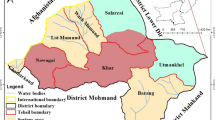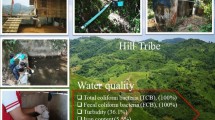Abstract
Water was sampled from over 100 sources in Nepal’s Kathmandu Valley, including municipal taps, dug wells, shallow-aquifer tube wells, deep-aquifer tube wells, and dhunge dharas (or stone spouts, public water sources that capture groundwater or surface water). Information was gathered on user preference and site and well characteristics, and water was examined for indicators of contamination from sewage, agriculture, or industry. Most problematic were total coliform and Escherichia coli bacteria, which were present in 94 and 72% of all the water samples, respectively. Contamination by nitrate, ammonia and heavy metals was more limited; nitrate and ammonia exceeded Nepali guidelines in 11 and 45% of the samples, respectively. Arsenic and mercury exceeded WHO guidelines in 7 and 10% of the samples, respectively, but arsenic never exceeded the less strict Nepali guideline. Significant differences existed in contamination levels between types of sources; dug wells and dhunge dharas, being the shallowest, were the most contaminated by bacteria and nitrate; deep-aquifer tube wells were the most contaminated by arsenic. Whereas E. coli concentrations decreased with depth, iron and ammonia concentrations increased with depth. These relationships account for people choosing to drink water with higher levels of bacterial contamination based on its superior (non-metallic) taste and appearance.
Résumé
Plus de 100 points d’eau de la Vallée de Kathmandu au Népal ont été échantillonnés, incluant des bornes municipales, des puits artisanaux, des forages dans des aquifères phréatiques, des forages dans des aquifères profonds et des dhunge dharas (sources publiques aménagées, qui captent les eaux souterraines ou de surface). Des informations ont été recueillies concernant les préférences des usagers ainsi que les caractéristiques du site et du puits, et l’eau a été analysée pour les indicateurs de contamination par les égouts, l’agriculture ou l’industrie. Les coliformes totaux et les bactéries Escherichia coli sont les plus problématiques, présents dans respectivement 94 et 72% des échantillons. La contamination par les nitrates, l’ammonium et les métaux lourds est plus limitée; 11 et 45% des échantillons excédant les normes népalaises en nitrates et ammonium, respectivement. Les concentrations en arsenic et en mercure étaient supérieures aux normes de l’OMS dans 7 et 10% des échantillons, respectivement, mais l’arsenic n’a jamais excédé la norme népalaise, moins stricte. Des différences importantes du niveau de contamination ont été notées entre les différents type de points d’eau ; les moins profonds de type puits artisanaux et dhunge dharas étaient affectés par les bactéries et les nitrates ; les forages dans les aquifères profonds étaient les plus contaminés par l’arsenic. Tandis que la concentration en E. Coli décroît avec la profondeur, les concentrations en fer et ammonium augmentent. Cette relation est importante, car des gens choisissent de boire une eau avec de fortes concentrations en bactéries, se basant plus sur l’apparence et l’aspect gustatif (non-métallique).
Resumen
En el Valle de Kathmandu (Nepal), se muestreó agua de aproximadamente 100 puntos de agua, incluyendo llaves municipales, pozos excavados, sondeos en acuíferos someros, sondeos en acuíferos profundos y dhunge dharas (o surtidores de piedra, fuentes públicas de agua que suministran aguas subterráneas o superficiales). La información fue recogida según las preferencias de los usuarios y las características del punto y del pozo, y el agua se analizaron indicadores de contaminación de aguas fecales, agricultura o industria. El mayor problema fue el total de coliformes y las bacterias Escherichia coli, que estaban presentes en el 94 y el 72% de todas las muestras de agua, respectivamente. La contaminación por nitratos, amonio y metales pesados fue más limitada; los nitratos y el amonio excede las normas Nepalíes en el 11 y 45% de las muestras, respectivamente. El arsénico y el mercurio exceden las normas WHO en un 7 y un 10% de las muestras, respectivamente, pero el arsénico no excede en ningún caso las normas Nepalíes, menos estrictas. Existen diferencias significativas en los niveles de contaminación entre los tipos de puntos de agua; los pozos excavados y los dhunge dharas, como son los más someros, son los más contaminados por bacterias y nitratos; los sondeos de acuíferos profundos son los más contaminados por arsénico. Mientras que las concentraciones de E. coli descendieron con la profundidad, las concentraciones de hierro y amonio se incrementaron con la misma. Estas relaciones condicionan que la gente elija beber agua con un nivel alto de contaminación por bacterias debido a su mejor gusto (no metálico) y su apariencia.



Similar content being viewed by others
References
Becker-Ritterspach ROA (1990) Dhunge-dharas in the Kathmandu Valley: an outline of their architectural development. Ancient Nepal 116–118:1−9
Brown RL, Watkins MD (1994) Problems associated with the use of urban aquifers for water supply to Kathmandu, Nepal. In: Groundwater problems in urban areas. Lavosier, Cahen, France, pp 251–262
Collins R, Jenkins A (1996) The impact of agricultural land use on stream chemistry in the Middle Hills of the Himalayas, Nepal. J Hydrol 185(1):71–86(16)
Conan H (2004) Small piped water networks: helping local entrepreneurs to invest. Water for All Publication Series, vol 13, Asian Development Bank, Manilla, Philippines
Conboy MJ, Goss MJ (2000) Natural protection of groundwater against bacteria of fecal origin. J Contam Hydrol 43:1–24
Chettri M, Smith GD (1995) Nitrate pollution in groundwater in selected districts of Nepal. Hydrogeol J 3:71–76
Cresswell RG, Bauld J, Jacobson G, Khadka MS, Jha MG, Shrestha MP, Regmi S (2001) A first estimate of ground water ages for the deep aquifer of the Kathmandu Basin, Nepal, using the radioisotope chlorine-36. Ground Water 39:449–457
Dixit A, Upadhya M (2005) Augmenting groundwater in Kathmandu Valley: challenges and possibilities. Nepal Water Conservation Foundation, Kathmandu, Nepal
Dongol BS, Merz J, Schaffner M, Nakarmi G, Shah BP, Shrestha SK, Dangol PM, Dhakal MP (2005) Shallow groundwater in the middle mountain catchment of Nepal: quantity and quality issues. Environ Geol 49:219–229
Edmunds WM, Smedley PL (1996) Groundwater geochemistry and health: an overview. Geol Soc Lond Spec Publ 113:91–105
Freedman D, Pisani R, Purves R (1998) Statistics, 3rd edn. Norton, New York
Government of Nepal, Ministry of Land Reform Management (2005) National Drinking Water Quality Standards, 2062 and National Drinking Water Quality Standard Implementation Guideline, 2062 Year: 2063 (BS) Singhadurbar, Kathmandu, Nepal (In Nepali)
HACH (1999) Portable datalogging colorimeter instrument manual, 5th edn. HACH, Loveland, CO, USA
Jha MG, Khadka MS, Shrestha MP, Regmi S, Bauld J, Jacobson G (1997) The assessment of groundwater pollution in the Kathmandu Valley, Nepal: report on Joint Nepal-Australia Project 1995–96, Australian Geological Survey Organisation, Canberra, pp 1–64
Karn SK, Harada H (2001) Surface water pollution in three urban territories of Nepal, India, and Bangladesh. Environ Manage 28(4):483–496
Khadka MS (1992) Nepal: groundwater quality. In: Groundwater quality monitoring in Asia and the Pacific. Water Resources Series, United Nations, New York 70:202–204
Khadka MS (1993) The groundwater quality situation in alluvial aquifers of the Kathmandu Valley, Nepal. AGSO J Aust Geol Geophys 14:207–211
Khadka MS (1994) Water quality of the municipal water supply in Kathmandu Valley. In: Proceedings, vol 1, Water Down Under Conference, Adelaide, Australia November 1994, pp 571–575
Khatiwada NR, Takizawa S, Tran TVN, Inoue M (2002) Groundwater contamination assessment for sustainable water supply in Kathmandu Valley, Nepal. Water Sci Technol 46(9):147–154
Moench M, Dixit A, Janakarajan S, Rathore MS, Mudrakartha S (2003) The fluid mosaic: water governance in the context of variability, uncertainty and change, a synthesis paper. National Water Conservation Foundation, Kathmandu, Nepal and the Institute for Social and Environmental Transition, Boulder, CO, USA
Panthi SR, Sharma S, Mishra AK (2006) Recent Status of arsenic contamination in groundwater of Nepal: a review. Kathmandu Univ J Sci Eng Technol 2(1):1–11
Sharma CK (1990) Chemical pollution of the soil and groundwater in the Kingdom of Nepal. Ground Monit Manage 173:391–397
Shrestha OM, Koirala A, Hanisch J, Busch K, Kerntke M, Jagar S (1999) A geo- environmental map for the sustainable development of the Kathmandu Valley, Nepal. Geojournal 49:165–172
Shrestha SD, Karmacharya R, Rao GK (1996) Estimation of groundwater resources in Kathmandu Valley, Nepal. J Ground Hydrol 38:29–40
Snedecor GW, Cochran WG (1980) Statistical methods, 7th edn. Iowa State University Press, Ames, Iowa
Yoshida M, Igarashi Y (1984) Neogene to Quaternary lacustrine sediments in the Kathmandu Valley, Nepal. J Nepal Geol Soc 4:73–100
Wolfe ANC (2000) Microbial contamination in the Kathmandu Valley drinking water supply and the Bagmati River. MSci Thesis, Massachusetts Institute of Technology, Boston, MA
Wonnacott RJ, Wonnacott TH (1985) Introductory statistics, 4th edn. Wiley, New York
World Health Organization (2004) Guidelines for drinking-water quality, vol 1, 3rd edn. Health criteria and other supporting information. World Health Organization, Geneva, Switzerland
Acknowledgements
The authors would like to acknowledge the numerous supporters whose time, effort and funding have made this research possible. The project was funded by a Hampton Grant from Miami University, the Department of Geology, Miami University, and the Geological Society of America. Dr. Janardan Subedi and Dilip Croung gave us guidance, logistics, and support while within Nepal and made the sampling process a possibility. Apex Trekking also provided guidance and language interpretation while in Nepal. We would also like to thank The Hotel Tibet, Kathmandu for providing housing and laboratory facilities. K. Harpp would like to acknowledge support for ICP-MS operation from NSF grant CHE-9996136.
Author information
Authors and Affiliations
Corresponding author
Rights and permissions
About this article
Cite this article
Warner, N.R., Levy, J., Harpp, K. et al. Drinking water quality in Nepal’s Kathmandu Valley: a survey and assessment of selected controlling site characteristics. Hydrogeol J 16, 321–334 (2008). https://doi.org/10.1007/s10040-007-0238-1
Received:
Accepted:
Published:
Issue Date:
DOI: https://doi.org/10.1007/s10040-007-0238-1




